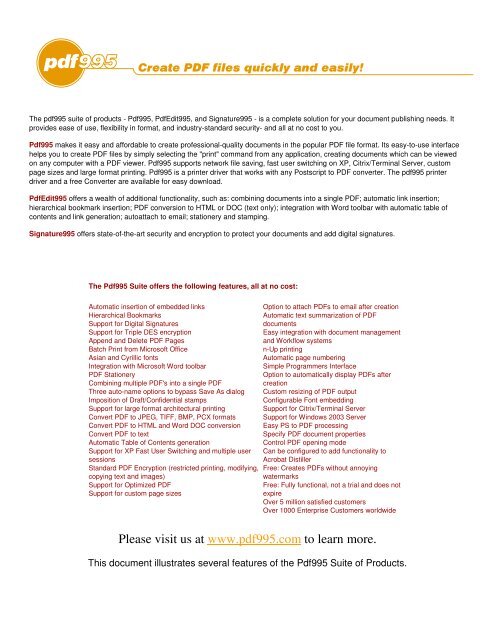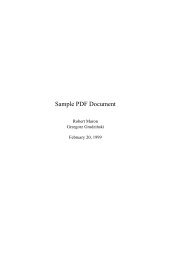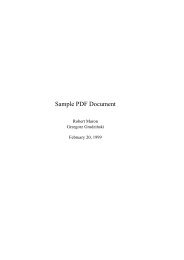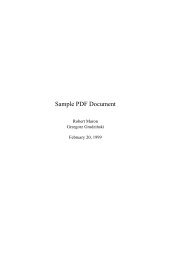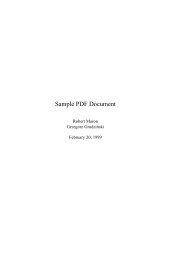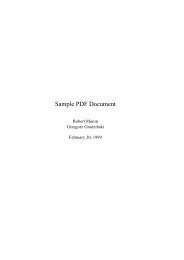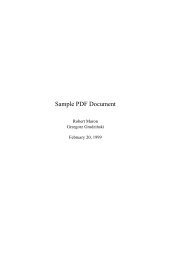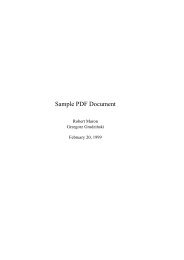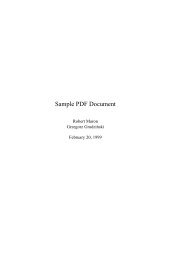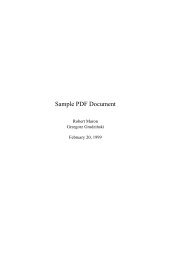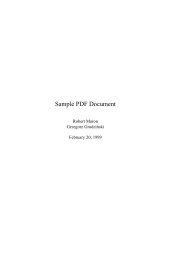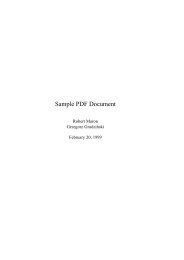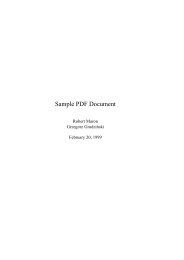pdf 4
You also want an ePaper? Increase the reach of your titles
YUMPU automatically turns print PDFs into web optimized ePapers that Google loves.
The <strong>pdf</strong>995 suite of products - Pdf995, PdfEdit995, and Signature995 - is a complete solution for your document publishing needs. It<br />
provides ease of use, flexibility in format, and industry-standard security- and all at no cost to you.<br />
Pdf995 makes it easy and affordable to create professional-quality documents in the popular PDF file format. Its easy-to-use interface<br />
helps you to create PDF files by simply selecting the "print" command from any application, creating documents which can be viewed<br />
on any computer with a PDF viewer. Pdf995 supports network file saving, fast user switching on XP, Citrix/Terminal Server, custom<br />
page sizes and large format printing. Pdf995 is a printer driver that works with any Postscript to PDF converter. The <strong>pdf</strong>995 printer<br />
driver and a free Converter are available for easy download.<br />
PdfEdit995 offers a wealth of additional functionality, such as: combining documents into a single PDF; automatic link insertion;<br />
hierarchical bookmark insertion; PDF conversion to HTML or DOC (text only); integration with Word toolbar with automatic table of<br />
contents and link generation; autoattach to email; stationery and stamping.<br />
Signature995 offers state-of-the-art security and encryption to protect your documents and add digital signatures.<br />
The Pdf995 Suite offers the following features, all at no cost:<br />
Automatic insertion of embedded links<br />
Hierarchical Bookmarks<br />
Support for Digital Signatures<br />
Support for Triple DES encryption<br />
Append and Delete PDF Pages<br />
Batch Print from Microsoft Office<br />
Asian and Cyrillic fonts<br />
Integration with Microsoft Word toolbar<br />
PDF Stationery<br />
Combining multiple PDF's into a single PDF<br />
Three auto-name options to bypass Save As dialog<br />
Imposition of Draft/Confidential stamps<br />
Support for large format architectural printing<br />
Convert PDF to JPEG, TIFF, BMP, PCX formats<br />
Convert PDF to HTML and Word DOC conversion<br />
Convert PDF to text<br />
Automatic Table of Contents generation<br />
Support for XP Fast User Switching and multiple user<br />
sessions<br />
Standard PDF Encryption (restricted printing, modifying,<br />
copying text and images)<br />
Support for Optimized PDF<br />
Support for custom page sizes<br />
Option to attach PDFs to email after creation<br />
Automatic text summarization of PDF<br />
documents<br />
Easy integration with document management<br />
and Workflow systems<br />
n-Up printing<br />
Automatic page numbering<br />
Simple Programmers Interface<br />
Option to automatically display PDFs after<br />
creation<br />
Custom resizing of PDF output<br />
Configurable Font embedding<br />
Support for Citrix/Terminal Server<br />
Support for Windows 2003 Server<br />
Easy PS to PDF processing<br />
Specify PDF document properties<br />
Control PDF opening mode<br />
Can be configured to add functionality to<br />
Acrobat Distiller<br />
Free: Creates PDFs without annoying<br />
watermarks<br />
Free: Fully functional, not a trial and does not<br />
expire<br />
Over 5 million satisfied customers<br />
Over 1000 Enterprise Customers worldwide<br />
Please visit us at www.<strong>pdf</strong>995.com to learn more.<br />
This document illustrates several features of the Pdf995 Suite of Products.
Introduction<br />
The Virtual Reality Modeling Language (VRML) is a language for describing multiparticipant<br />
interactive simulations -- virtual worlds networked via the global Internet and<br />
hyperlinked with the World Wide Web. All aspects of virtual world display, interaction<br />
and internetworking can be specified using VRML. It is the intention of its designers that<br />
VRML become the standard language for interactive simulation within the World Wide<br />
Web.<br />
The first version of VRML allows for the creation of virtual worlds with limited<br />
interactive behavior. These worlds can contain objects which have hyperlinks to other<br />
worlds, HTML documents or other valid MIME types. When the user selects an object<br />
with a hyperlink, the appropriate MIME viewer is launched. When the user selects a link<br />
to a VRML document from within a correctly configured WWW browser, a VRML<br />
viewer is launched. Thus VRML viewers are the perfect companion applications to<br />
standard WWW browsers for navigating and visualizing the Web. Future versions of<br />
VRML will allow for richer behaviors, including animations, motion physics and realtime<br />
multi-user interaction.<br />
This document specifies the features and syntax of Version 1.0 of VRML.<br />
VRML Mission Statement<br />
The history of the development of the Internet has had three distinct phases; first, the<br />
development of the TCP/IP infrastructure which allowed documents and data to be stored<br />
in a proximally independent way; that is, Internet provided a layer of abstraction between<br />
data sets and the hosts which manipulated them. While this abstraction was useful, it was<br />
also confusing; without any clear sense of "what went where", access to Internet was<br />
restricted to the class of sysops/net surfers who could maintain internal cognitive maps of<br />
the data space.<br />
APPROVED<br />
Next, Tim Berners-Lee’s work at CERN, where he developed the hypermedia system<br />
known as World Wide Web, added another layer of abstraction to the existing structure.<br />
This abstraction provided an "addressing" scheme, a unique identifier (the Universal<br />
Resource Locator), which could tell anyone "where to go and how to get there" for any<br />
piece of data within the Web. While useful, it lacked dimensionality; there’s no there<br />
there within the web, and the only type of navigation permissible (other than surfing) is<br />
by direct reference. In other words, I can only tell you how to get to the VRML Forum<br />
home page by saying, "http://www.wired.com/", which is not human-centered data. In
fact, I need to make an effort to remember it at all. So, while the World Wide Web<br />
provides a retrieval mechanism to complement the existing storage mechanism, it leaves<br />
a lot to be desired, particularly for human beings.<br />
Finally, we move to "perceptualized" Internetworks, where the data has been sensualized,<br />
that is, rendered sensually. If something is represented sensually, it is possible to make<br />
sense of it. VRML is an attempt (how successful, only time and effort will tell) to place<br />
humans at the center of the Internet, ordering its universe to our whims. In order to do<br />
that, the most important single element is a standard that defines the particularities of<br />
perception. Virtual Reality Modeling Language is that standard, designed to be a<br />
universal description language for multi-participant simulations.<br />
These three phases, storage, retrieval, and perceptualization are analogous to the human<br />
process of consciousness, as expressed in terms of semantics and cognitive science.<br />
Events occur and are recorded (memory); inferences are drawn from memory<br />
(associations), and from sets of related events, maps of the universe are created (cognitive<br />
perception). What is important to remember is that the map is not the territory, and we<br />
should avoid becoming trapped in any single representation or world-view. Although we<br />
need to design to avoid disorientation, we should always push the envelope in the kinds<br />
of experience we can bring into manifestation!<br />
This document is the living proof of the success of a process that was committed to being<br />
open and flexible, responsive to the needs of a growing Web community. Rather than reinvent<br />
the wheel, we have adapted an existing specification (Open Inventor) as the basis<br />
from which our own work can grow, saving years of design work and perhaps many<br />
mistakes. Now our real work can begin; that of rendering our noospheric space.<br />
History<br />
VRML was conceived in the spring of 1994 at the first annual World Wide Web<br />
Conference in Geneva, Switzerland. Tim Berners-Lee and Dave Raggett organized a<br />
Birds-of-a-Feather (BOF) session to discuss Virtual Reality interfaces to the World Wide<br />
Web. Several BOF attendees described projects already underway to build three<br />
dimensional graphical visualization tools which interoperate with the Web. Attendees<br />
agreed on the need for these tools to have a common language for specifying 3D scene<br />
description and WWW hyperlinks -- an analog of HTML for virtual reality. The term<br />
Virtual Reality Markup Language (VRML) was coined, and the group resolved to begin<br />
specification work after the conference. The word ’Markup’was later changed to<br />
’Modeling’to reflect the graphical nature of VRML.<br />
APPROVED
Shortly after the Geneva BOF session, the www-vrml mailing list was created to discuss<br />
the development of a specification for the first version of VRML. The response to the list<br />
invitation was overwhelming: within a week, there were over a thousand members. After<br />
an initial settling-in period, list moderator Mark Pesce of Labyrinth Group announced his<br />
intention to have a draft version of the specification ready by the WWW Fall 1994<br />
conference, a mere five months away. There was general agreement on the list that, while<br />
this schedule was aggressive, it was achievable provided that the requirements for the<br />
first version were not too ambitious and that VRML could be adapted from an existing<br />
solution. The list quickly agreed upon a set of requirements for the first version, and<br />
began a search for technologies which could be adapted to fit the needs of VRML.<br />
The search for existing technologies turned up a several worthwhile candidates. After<br />
much deliberation the list came to a consensus: the Open Inventor ASCII File Format<br />
from Silicon Graphics, Inc. The Inventor File Format supports complete descriptions of<br />
3D scenes with polygonally rendered objects, lighting, materials, ambient properties and<br />
realism effects. A subset of the Inventor File Format, with extensions to support<br />
networking, forms the basis of VRML. Gavin Bell of Silicon Graphics has adapted the<br />
Inventor File Format for VRML, with design input from the mailing list. SGI has publicly<br />
stated that the file format is available for use in the open market, and have contributed a<br />
file format parser into the public domain to bootstrap VRML viewer development.<br />
APPROVED
A Graphical Representation of Inverse VRML Uptake<br />
Inverse usage<br />
140<br />
120<br />
100<br />
80<br />
60<br />
40<br />
20<br />
0<br />
0<br />
10<br />
20<br />
30<br />
40<br />
50<br />
60<br />
Change the number in red below to adjust for download rate and/or bandwidth.<br />
1 The number 1 represents an engineer with an "average" cube *<br />
EANx EANx<br />
fsw Air<br />
CF Min<br />
32% 36%<br />
80.0 149.12 0<br />
61.4 114.43 10<br />
49.8 92.846 20<br />
41.9 78.102 30 180<br />
36.2 67.402 40 120<br />
31.8 59.275 50 80.0 147.0 192.0<br />
28.4 52.9 60 57.0 92.0 123.0<br />
25.6 47.774 70 40.0 65.0 79.0<br />
23.4 43.543 80 30.0 49.0 59.0<br />
21.5 40.001 90 24.0 37.0 45.0<br />
19.9 37 100 19.0 30.0 35.0<br />
18.5 34.409 110 16.0 25.0 29.0<br />
17.3 32.154 120 13.0 20.0 n/a<br />
16.2 30.178 130 10.0 17.0 n/a<br />
15.1 28.202 140 8.0 n/a n/a<br />
70<br />
80<br />
90<br />
Days after download<br />
100<br />
Programmers<br />
Technical Writers<br />
QA<br />
Other<br />
110<br />
120<br />
130<br />
140<br />
Inverse log usage<br />
APPROVED<br />
90<br />
80<br />
70<br />
60<br />
50<br />
40<br />
30<br />
20<br />
10<br />
0<br />
50<br />
60<br />
70<br />
80<br />
90<br />
100<br />
Days after download<br />
110<br />
Artists<br />
Musicians<br />
Politicians<br />
Dentists<br />
120<br />
130<br />
140


